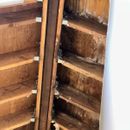How important is staggering seams with exterior insulation?
Hi all, looking to install 2″ polyiso nailbase for cathedral ceiling condensation control in climate zone 3.
I would imagine that a single layer of foam will never have perfect seams everywhere due to damage during install, making cuts around the ridge or hips, etc.
The roof will have an air barrier on the structural deck, then polyiso insulation nailbase, roofing membrane, and a metal roof.
Is the theory that as long as the seams are not too big, then they will likely still cause condensation on the interior of the plywood, but should be able to dry to the inside over time? I had a pretty devastating condensation failure even in climate zone 3 in just 8 years due to the builder not using any exterior insulation so I’m a bit worried about ensuring the repair will not fail.
I can’t do multiple layers of polyiso due to building height restrictions and I can’t find a roofer comfortable with exterior insulation, so a single layer of nail base was the best compromise I could find to find a framer and roofer willing to take on the project. I also prefer not to spray foam the rafters as a solution.
Note: the damage was almost exclusively to the north facing side of the roof, assuming due to that side of the roof not getting hot enough to drive the condensation back into the interior.
P.S. I apologize for posting multiple questions regarding the same topic, I’m just learning as I go, questions come up, and really want to make sure to get these details right.
GBA Detail Library
A collection of one thousand construction details organized by climate and house part










Replies
Generally you want to stagger when doing thick layers of rigid or when the rigid itself is the air barrier. Neither would be the case for you.
For 2" over-roof, it doesn't matter.
Make sure to protect the edges of the nailbase at eaves and rake ends. You don't want any foam exposed, you want all sides covered by lumber.
Deleted
Will you be embarrassed when people see the frost patterns on your roof?
https://buildingscience.com/documents/insights/bsi-056-leiningen-versus-the-ants-redux
Walta
Thank you, Arkos. Since the home has zero overhangs, I was hoping to take the insulation all the way to the edge so I can cover most of the roof, and just cover it with either a second layer of peel and stick and the roof edge flashing, or just the edge flashing if the roofer doesn’t use a peel and stick.
Could you please explain why I shouldn’t leave any foam exposed and would wrapping it with a peel and stick suffice since it will just be covered with flashing, nothing should be nailed to it? Or should I use the edge nailers regardless of the loss of insulation for the roof in those areas?
Here’s what the original construction looked like (photos from previous owner) . Luckily the damage seems to only be on the roof and not the walls considering how they constructed it. https://photos.app.goo.gl/7yxJg6k562F5PXUk7
Walta, the roof is not very visible, I’m only concerned with interior damage since this repair is strictly due to an unvented cathedral failure.
Depends a lot on how persistent local critters are. I had foam exposed during construction and within 4 months a squirrel chewed through it and set up a nest.
Anything critter proof will work, properly installed flashing is fine. Not sure about peel and stick.
If I remember you are in a warmer climate, if you go with full lumber around the edge, this little bit of R value loss is essentially noise in terms of building energy use.
I find lumber the easiest as it gives you something solid to nail trim into.
Thank you, understood and yes I am in climate zone 3B, Los Angeles county (3 miles from the water).
As I stated before, I had the impression that any area that doesn't have some foam coverage could become a condensing surface, but the more I think about it and per your explanations, it seems like, yes they will be condensing surfaces, but they should be minor amounts that can dry towards the interior over time, whereas my failure with no exterior insulation was due to the moisture not being able to dry towards the interior fast enough and kept accumulating.
I hope I am understand it properly, and in that case, if the roofer can't turn down the peel and stick membrane over the insulation and onto the wall to fully encapsulate the foam, then I will use edge nailers instead.
You may find this article interesting.
https://www.greenbuildingadvisor.com/article/five-cathedral-ceilings-that-work
Walta